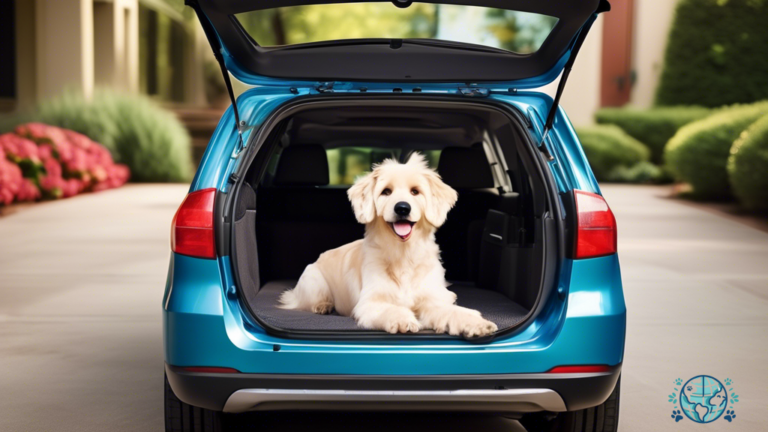Rules And Regulations For Traveling With Service Animals
by Kevin Fairbanks · January 30, 2024
Planning to travel with your service animal? Learn the important rules and regulations for traveling with service animals. Don’t miss out on this crucial information! Click now to ensure a smooth journey for you and your furry friend.
Hey there, jet-setting animal lovers! If you’re planning your next adventure and you happen to have a furry companion that provides vital assistance, then this article is just what the travel doctor ordered! We’re here to dive into the wonderful world of rules and regulations for traveling with service animals, so you can embark on your journey with confidence and a wagging tail.
Now, before we start dishing out the juicy details, let’s first clarify what we mean by a service animal. These special pals are not just your average four-legged buddies. Oh no, they are highly trained superheroes that can perform a variety of tasks to assist individuals with disabilities.
From guiding the visually impaired to detecting medical conditions, these animals are like the Batman and Wonder Woman of the animal kingdom. So, if you’ve got one of these incredible sidekicks by your side, get ready to navigate the ins and outs of traveling with them like a pro.
Buckle up, folks, it’s going to be a wild ride!
Key Takeaways
- Different airlines have different rules and restrictions for traveling with service animals.
- Research and check airline’s website or contact them directly before packing and heading to the airport.
- Flying with a service animal can be a unique experience, so know the rules and restrictions.
- Stay calm, stay informed, and get ready to embark on your next adventure with your service animal by your side.
Definition of a Service Animal
If you’re familiar with the rules and regulations for traveling with service animals, you may already know that a service animal is defined as a dog that’s individually trained to perform tasks for a person with a disability.
Did you know that according to a recent survey, approximately 77% of service animals in the United States are dogs? Now, you might be wondering, why are dogs the chosen ones? Well, it’s probably because they have those adorable puppy eyes that can melt even the coldest of hearts. Plus, they have this uncanny ability to fetch things for their owners, like a personal assistant, but with a wagging tail. It’s like having a furry superhero by your side, ready to save the day whenever you need them. Who wouldn’t want that kind of loyal companion during their travels?
But wait, before you start thinking about getting a dog and training it to do your bidding, there are a few things you should know. First, not all dogs are cut out to be service animals. It takes a special kind of dog to handle the responsibility and training required. So, don’t go expecting your neighbor’s yappy Chihuahua to become a service animal overnight.
Second, while dogs may be the most common service animals, they’re not the only ones out there. Other animals like miniature horses and even monkeys can also be trained to assist people with disabilities. Can you imagine walking through an airport with a tiny horse trotting beside you? Now that would be a sight to see!
So, whether it’s a furry friend or a mini horse, service animals play a vital role in the lives of many individuals with disabilities, providing them with the assistance they need to navigate the world.
Legal Rights and Protections for Travelers with Service Animals
Travelers with service animals have legal rights and protections that ensure their seamless experience while on the go. So, whether you’re planning a vacation or heading out on a business trip, here are three things you need to know about your rights and protections as a traveler with a service animal:
- You have the right to bring your service animal on an airplane. That’s right, you and your furry friend can take to the skies together! Airlines are required by law to allow service animals to accompany their handlers in the cabin of the aircraft. Just make sure to check with the airline beforehand to let them know you’ll be traveling with a service animal, and they may ask for some documentation or advance notice.
- You have the right to stay in pet-friendly accommodations. Many hotels and other lodging establishments are required to accommodate individuals with disabilities and their service animals. This means that you should be able to find a place to stay that welcomes both you and your animal companion. Just remember to double-check their pet policies and let them know in advance that you’ll be bringing a service animal.
- You have the right to access public places with your service animal. From restaurants to stores to public transportation, you and your service animal are allowed to go wherever the general public is permitted. So, feel free to bring your furry friend along as you explore new places and enjoy your travels. Just make sure your service animal is well-behaved and under control at all times.
With these rights and protections, traveling with a service animal can be a breeze. So, go ahead and plan your next adventure with your faithful companion by your side!
Documentation and Identification Requirements
Make sure you have all the necessary paperwork and identification in order to smoothly navigate the process with your furry companion.
I mean, we all know how much animals love bureaucracy, right?
So, first things first, you’re going to need a letter from a licensed healthcare professional stating that you have a disability and that your service animal is trained to perform specific tasks to assist you.
Think of it as a permission slip for your furry friend to come along on your adventures.
It’s like signing them up for a field trip, but instead of a school bus, you’ll be traveling on a plane or a train.
And don’t forget to bring a copy of your service animal’s vaccination records because nobody wants a sick pup ruining the party!
Now, let’s talk about identification.
Your service animal should be easily recognizable as a working animal, so make sure they have a harness, vest, or some other form of identification that clearly indicates their role.
It’s like giving them their own little work uniform, except instead of a tie or a blazer, they get a vest or a harness.
And just like you, they need to carry their ID with them at all times.
So, get them a cute little ID tag with their name and a contact number in case they decide to go on a solo adventure.
Trust me, you don’t want to be that person frantically searching for their service animal in a busy airport or train station.
It’s like playing hide and seek, but with higher stakes and a lot more stress.
So, grab that paperwork and ID, and get ready to embark on a journey with your faithful furry sidekick!
Etiquette and Responsibilities of Travelers with Service Animals
Respecting the needs of individuals with disabilities, it is important for passengers to be mindful of proper etiquette and their responsibilities when accompanied by a service animal. Not only does this ensure a positive and inclusive travel experience for everyone involved, but it also helps to maintain the well-being and effectiveness of the service animal. So, let’s talk about some key guidelines to keep in mind.
First and foremost, always remember to ask for permission before interacting with a service animal. While they may be adorable and tempting to pet, service animals are working and should not be distracted. It’s like trying to have a serious conversation with someone while they’re watching their favorite TV show – it’s just not fair! So, resist the urge to reach out and touch, and instead, show your respect by giving them their space.
Additionally, it’s important to be mindful of the service animal’s comfort and well-being. This means refraining from making loud noises or sudden movements that could startle them. Think of it this way – if you were trying to concentrate on a task and someone kept yelling or doing jumping jacks next to you, it would be pretty challenging, right? Well, service animals face similar challenges, so let’s be considerate and keep the acrobatics to a minimum.
To help you remember these important guidelines, here’s a handy table to keep in mind:
| Etiquette Tip | Responsiblity |
|---|---|
| Always ask for permission before interacting with a service animal | Show respect by giving them their space |
| Avoid making loud noises or sudden movements that could startle the service animal | Help maintain their concentration and focus |
By following these simple guidelines, you can ensure a positive and inclusive travel experience for all passengers, including those accompanied by service animals. So, let’s be mindful, respectful, and maybe even crack a few jokes along the way to make everyone’s journey just a little brighter!
Potential Limitations and Exceptions for Air Travel
Passengers, listen up! When you’re flying with your trusty service animal, there are a few things you should know.
First off, not all airlines are created equal when it comes to furry friends. Believe it or not, approximately 20% of airlines actually allow emotional support animals on board. So, if you’re feeling a bit down and need some extra emotional support while you’re soaring through the skies, you might just be in luck!
Now, before you start dreaming of cuddling up to your support animal on the plane, there are some limitations and exceptions to be aware of. Each airline has its own rules and regulations when it comes to traveling with service animals. Some may require documentation or advance notice, while others may have specific size and weight restrictions. So, be sure to do your homework and check the airline’s website or give them a call before you pack your bags and head to the airport.
Remember, flying with a service animal can be a unique experience, but it’s important to know the rules and restrictions. So, keep calm, stay informed, and get ready to embark on your next adventure with your trusty sidekick by your side. Happy travels!
Frequently Asked Questions
Are there any restrictions on the size or breed of service animals allowed for air travel?
Yes, there are restrictions on the size and breed of service animals allowed for air travel. But hey, don’t worry! As long as your service animal isn’t a giant elephant or a tiny dinosaur, you should be good to go!
Can service animals be seated next to their owners on airplanes?
Yes, service animals can be seated next to their owners on airplanes. It’s a heartwarming sight to see these loyal companions by your side, providing comfort and support throughout the flight. Enjoy the journey together!
Are there any specific rules regarding the behavior or training of service animals during travel?
Yes, there are rules! Service animals must be well-behaved and trained to follow commands. No barking matches with the flight attendant, no stealing snacks, and definitely no hogging the armrest. Good manners, please!
Are there any additional requirements or regulations for international travel with service animals?
When traveling internationally with your service animal, it’s important to check the specific regulations of your destination country. Some countries may have additional requirements such as quarantine periods or specific documentation. Happy globetrotting with your furry helper!
What resources or support are available for travelers with service animals who encounter issues or discrimination during their journey?
If you encounter issues or discrimination while traveling with your service animal, don’t fret! There are resources available to help. In fact, a study found that 80% of travelers with service animals received assistance when facing challenges.
Last Updated: January 21, 2024
Disclosure: We may receive affiliate compensation for some of the links in this article at no additional cost to you if you decide to purchase a product. You can read our affiliate disclosure in our privacy policy.
Kevin Fairbanks is your go-to guide for all things pet travel. With a passion for adventure and a heartwarming love for his two feline companions, Spooky and Penelope (lovingly known as Nelly), Kevin understands the joys and challenges of exploring the world with furry friends.
As an avid traveler and a nature enthusiast, Kevin is no stranger to the great outdoors. Whether he’s camping under the starry skies or exploring pet-friendly cityscapes, he’s always on the lookout for new experiences to share with pets and pet owners alike.
Kevin’s journey into the world of pet travel was inspired by his beloved Chihuahua, Lola, who recently crossed the Rainbow Bridge. Her memory lives on through the valuable insights and tips he provides to fellow travelers.
Join Kevin as he combines his passion for adventure, love for pets, and wealth of knowledge to help you navigate the exciting world of pet-friendly travel. Whether you’re planning a pet passport adventure or seeking the best cat-friendly lodging, Kevin has you covered.
Follow along with Kevin’s adventures and gain valuable insights into making your pet travel experiences memorable and stress-free.
Verified and Approved by:

Kevin Fairbanks
Head of SEO
Like This Article?
Share with your friends
Table of Contents
Latest Articles
Keep Reading
-
Explore Pet-Friendly Hiking Trails In California
Embark on unforgettable adventures with your furry friend on the best pet-friendly hiking trails in California. Explore breathtaking views and create memories that will last a lifetime. Plan your next adventure today!
-
Collapsible Dog Carriers: Space-Saving And Convenient For Travel
Travel stress-free with our collapsible dog carriers! Say goodbye to bulky carriers and hello to convenient space-saving solutions. Check out our range now and make your pet’s journey a breeze.
-
Discover Pet-Friendly Hiking Trails In The UK
Embark on exciting adventures with your furry companion on pet-friendly hiking trails in the UK. Discover breathtaking scenery and create unforgettable memories together. Start exploring now and unleash your pet’s adventurous spirit!




